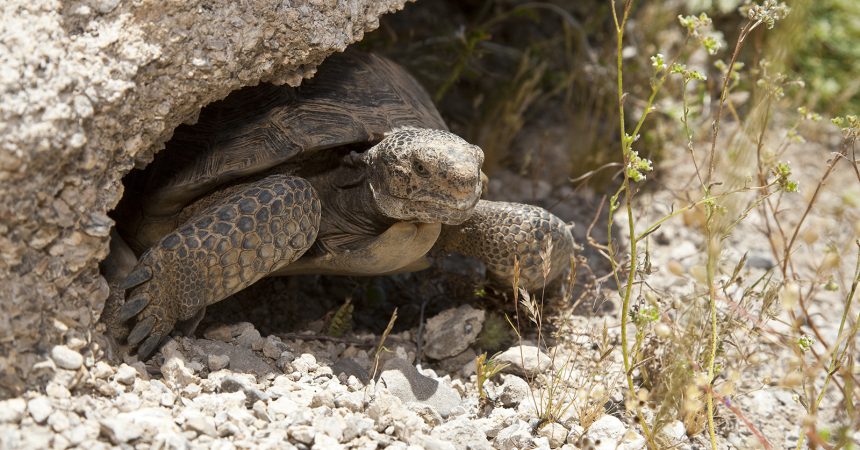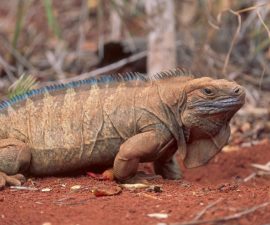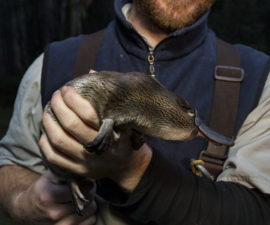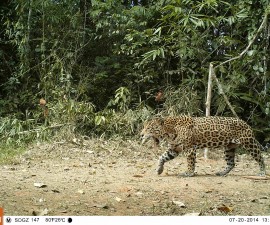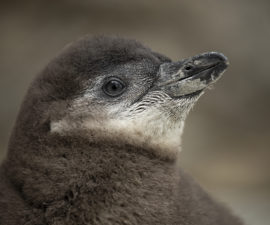San Diego Zoo Global conservationists reared young desert tortoises for one to two years before the planned release—a strategy referred to as “headstarting,” which provides a safe environment during their most vulnerable period, before translocating to the native habitat
A team of biologists—including members from the U.S. Geological Survey (USGS), Bajada Ecology, LLC and San Diego Zoo Global—released nearly 150 desert tortoises into the eastern Mojave Desert this month (October 2020), to support recovery of this iconic species. This conservation program was made possible by a large coalition of San Diego Zoo Global partners, including Edwards Air Force Base (EAFB), the U.S. Bureau of Land Management (BLM), Cadiz Inc. and the Living Desert Zoo and Gardens, with funding from the California Energy Commission, the U.S. Fish and Wildlife Service and the Favrot Fund. The tortoises were reared at purpose-built facilities at EAFB and Cadiz Inc., and some of the eggs were incubated and hatched at the Living Desert.
“This program provides an important opportunity to increase tortoise populations while also learning how certain features in their native habitat promote their ability to survive and thrive,” said Ron Swaisgood, Ph.D., director of Recovery Ecology at San Diego Zoo Global, who is one of the lead investigators in the study. “We hope the outcome will be improved protocols for translocating tortoises in the future.”
These young tortoises are now living in their native desert habitat at two locations where they were translocated: Edwards Air Force Base and BLM’s Ward Valley. “EAFB is excited to be a part of this program, as we have long been committed to recovering desert tortoise populations on the lands owned and managed by the base,” said Wesley King, a biological scientist at EAFB.
To enable conservation scientists with the ability to monitor the tortoises as they settle in to their native habitat, the tortoises all boast a radio tracking system. Tracking their movements—and their success in the new surroundings—is an important aspect of the program, as it will help scientists improve translocation protocols for future releases. Although scientists understand generally what constitutes suitable habitat for the species, this study will help them learn about specific resources in the environment that may make desert tortoises less vulnerable to predators, provide nourishment or provide protection from extreme temperatures.
Desert tortoises, a species native to the southwestern United States, have experienced rapid population decline and are considered to be threatened by the U.S. Fish and Wildlife Service and the California Department of Fish and Wildlife. Threats include habitat loss and degradation, disease and increased vulnerability to native predators, whose numbers have increased as a result of human activities. Ongoing collaborative efforts will inform future headstarting and translocation programs, allowing conservationists to identify habitat features that are most important in helping tortoises thrive in a changing landscape.
As a leader in wildlife conservation, the work of San Diego Zoo Global includes on-site wildlife conservation efforts (representing both plants and animals) at the San Diego Zoo, San Diego Zoo Safari Park, and San Diego Zoo Institute for Conservation Research, as well as international field programs on six continents. The work of these entities is made accessible to over 1 billion people annually, reaching 150 countries via social media, our websites and the San Diego Zoo Kids network, in children’s hospitals in 12 countries. The work of San Diego Zoo Global is made possible with support from our incredible donors committed to saving species from the brink of extinction.

